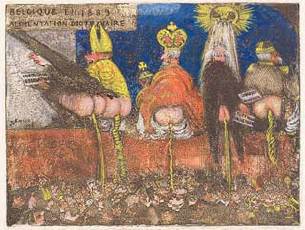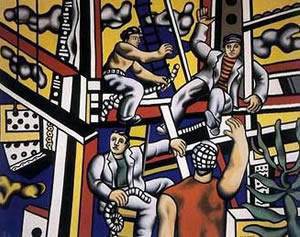
James Ensor (1860–1949),
Doctrinal Nourishment (Alimentation
Doctrinaire)
LACMA EXHIBITION FOCUSES ON RARE —AND PROVOCATIVE— ENSOR PRINT
Work expresses social and political critique through “black humor” – April – July 2008
]]>
The Los Angeles County Museum of Art (LACMA) presents a special exhibition featuring approximately fifty works on paper by the Belgian artist James Ensor and nineteen of his predecessors, contemporaries, and successors, on view from April 10 to July 6, 2008. At the center of the exhibition is Ensor’s etching, and LACMA’s recent acquisition, Doctrinal Nourishment [Alimentation Doctrinaire] (1889/95), a provocative send-up of authoritarian hubris that lampoons the Belgian ruling classes as bloated, self-satisfied tyrants, sitting, bare-bottomed, on a high wall and emptying their bowels into the awaiting mouths of a ravenous crowd. Created in 1889, this print critiqued the unstable socio-political climate aggravated and perpetuated by the oppressive policies of King Leopold II (1865–1909). By dismissing autocratic rule as a foul diet to be swallowed obediently by the masses, Ensor laid bare not only the brutality of Leopold’s regime, but also the people’s unquestioning willingness to accept it. “Doctrinal Nourishment”: Art and Anarchism in the Time of James Ensor is the first exhibition to examine his rare etching—one of only three hand-colored impressions in existence—in light of Ensor’s own political radicalism as well as that of artists who shared his subversive spirit.
Ensor was a painter, draftsman, and printmaker who was educated in the realist and impressionist traditions of the mid-nineteenth century, but who went on to marshal the bizarre, the macabre, the perverse, and the subversive into a scathing commentary on contemporary society. He was inspired by artists who inverted dominant discourses by pushing the boundaries of visual decorum, and he drew impetus, for example, from British and French political satire, particularly that of Charles Pilipon and Honoré Daumier (In Gargantua [1831], Daumier anticipates Ensor in lampooning the monarchy—in this case that of French King
Louis-Philippe—in a particularly vulgar way). Ensor was also an enthusiastic admirer of Francisco de Goya, who was notorious for exploiting the grotesque to expose humanity’s irrational side, as in one of his most recognizable works, The Sleep of Reason Produces Monsters (1799).
The exhibition brings together a variety of works by Ensor to add focus to the outrageous acerbity of Doctrinal Nourishment. A number of them, such as The Gendarmes (1888), Belgium in the XIXth Century (1889), and The Good Judges (1894), similarly make blatant reference to imbalances of power. Other works like The Cathedral (1886), The Entry of Christ into Brussels (1898), and The Baths at Ostend (1899), offer more subtle socio-political critiques.
A substantial portion of the exhibition is devoted to the dynamic exchange that Ensor shared with artistic contemporaries such as Odilon Redon and Félicien Rops, as well as with a younger generation of artists: including the German expressionists Otto Dix, Erich Heckel, Käthe Kollwitz, and Emil Nolde; and the dadaist George Grosz—all of whom, like Ensor, developed deliberately coarse styles and made liberal use of satire and caricatural line to speak to broad social inequities and expose more specifically the ineptness of those in power. Indeed, in fin-de-siècle and early twentieth-century avantgarde circles, the subversion of the authority of artistic tradition through the cultivation of one’s individual style was understood as a powerful weapon for social change.
In lampooning the ruling classes—the bishop and nun of the Catholic Party, the Liberal Party’s coat-tailed bureaucrat, the military officer, and King Leopold II—Doctrinal Nourishment operates firmly within this aesthetic. While expertly crafted, it is also deliberately and uniquely unconventional—its form is exaggerated; its space cramped; its surface muddied; and its subject, in the true spirit of black humor, is as grim as it is hilarious. In examining Doctrinal Nourishment both in light of Ensor’s career and of the tumultuous times in which it unfolded, “Doctrinal Nourishment”: Art and Anarchism in the Time of James Ensor not only celebrates the acquisition of a rare example of this remarkable artist’s work, but it also adds texture to our understanding of his pivotal position in the history of modern art.
Curated by Theresa Papanikolas, Wallis Annenberg Curatorial Fellow in the department of Prints and Drawings at LACMA, the exhibition brings Doctrinal Nourishment together with works selected primarily from LACMA’s significant holdings in Ensor and German expressionist prints, enhanced by key works from local institutions and private collections.
Follow us on:


